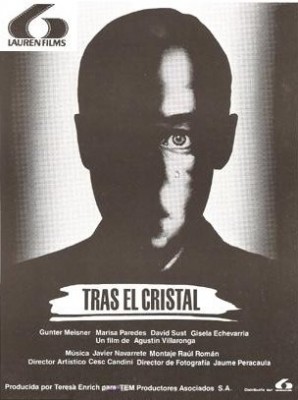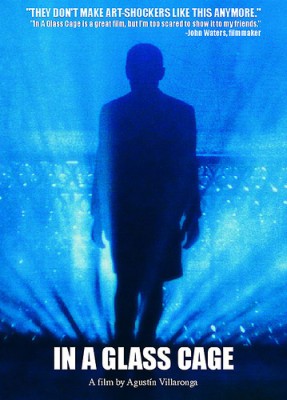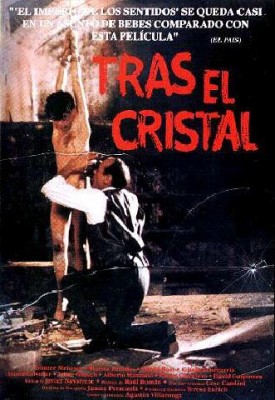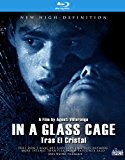| Reviews & Columns |
|
Reviews DVD TV on DVD Blu-ray 4K UHD International DVDs In Theaters Reviews by Studio Video Games Features Collector Series DVDs Easter Egg Database Interviews DVD Talk Radio Feature Articles Columns Anime Talk DVD Savant Horror DVDs The M.O.D. Squad Art House HD Talk Silent DVD
|
DVD Talk Forum |
|
|
| Resources |
|
DVD Price Search Customer Service #'s RCE Info Links |
|
Columns
|
|
|
In a Glass Cage

Agusti Villaronga's In a Glass Cage belongs to a tradition of European art films that is as unpleasant as it is (arguably) artistically vital and morally necessary. These movies aim to provoke a visceral sense of disgust and outrage by getting us far too close-in to the cruel, rancid, inhuman decadence represented by the ultra-right regimes (the Nazis in Germany, the Fascists in Italy) under which the Continent suffered during World War II, as well as the shameful history and lurid, sickly fascination/"nostalgia" that are their legacy. Some salient points on this tradition's timeline are Visconti's The Damned, Liliani Caviani's The Night Porter, and Pasolini's Salo, but more than any of those films, In a Glass Cage has an isolated intimacy that, in its more brutal moments, turns to a nightmarish claustrophobia. It is a film possessed of a cold beauty, flirting with exploitation and eliciting raw revulsion, but this controversial and problematic strategy could, potentially, offer more insight into the meaning of the real historical horrors to which the film refers than any more tactful narrative film or earnest documentary ever could.
Sometime in what looks to be the early to mid 1950s, Klaus (Günter Meisner, Willy Wonka & the Chocolate Factory), a genteel but mentally/emotionally rotted former Nazi "physician"/experimenter/torturer has escaped postwar justice by fleeing to a remote, palatial house in rural, fascist-ruled Spain, where he surreptitiously continues to do what he learned to savor with impunity during the war: molesting and murdering children in sadistically ritualistic ways and making writings, drawings, and photos of his vile actions for a scrapbook, as if his acts of violation were some ennobling, pseudo-Nietzschean philosophical experiment or art project. As the film begins, we witness Klaus through a basement window, from the spying POV of some as yet unknown character, in the act of committing an especially vicious murder; shortly thereafter, this unseen witness's hand retrieves the scrapbook from the floor, where Klaus has discarded it in his murderous passion. The gruesomeness of what Klaus has just done resuscitates some uninvited, long-buried glimmer of conscience in him, and he leaps off the roof of the villa in an attempt to head off the possibility of having to actually live with the incalculable remorse of his crimes.

But Klaus cannot erase his corrosive, horrendous presence on Earth so easily, and he survives, paralyzed below the neck, encased in a cylindrical, body-length iron lung with glass panels and tended to by his willfully oblivious wife, Griselda (Marisa Paredes, who subsequently became famous as an Almodovar muse and star of All About My Mother), and their prepubescent daughter, Rena (Gisèle Echevarria). Their call for an aide to help with their nursing/caretaking duties is answered abruptly by Alejandro (David Sust), a mysterious young man who seems not to have any medical experience whatsoever but who, after a private interview with Klaus in which he reveals that he is our witness from the film's opening who absconded with that vile scrapbook, is hired on at the insistence of his new "patient."
Alejandro has been studying up, and he has developed a fascination for Klaus and his crimes that spills over into the actually erotic; he is the lingering continuation of the poison Klaus tried to stamp out with his suicide. He sets up a mirror apparatus on the iron lung, set at such an angle so that Klaus can witness his "nurse"'s slavering replications of what he has seen so lovingly detailed in Klaus's memory-book. Griselda, suspicious and likely jealous of Alejandro, mistrusts him deeply; but as his boldness increases, and as he mutates emotionally and psychologically into the all-powerful, murder-delectating master of life and death he so admires Klaus for having been, Alejandro is able to forcefully remove the obstacle of Griselda, dismiss the maid, take over father-figure duties for Rena (who adores him), and get closer and closer to the malevolent heart of what Klaus represents as the invalid is forced to watch his evil memories reenacted before him as nightmares granted new life. It is eventually revealed that Klaus and Alejandro have a history together that, though Klaus has forgotten, the young man remembers very, very well, and as the film culminates and concludes on a ghastly, indelible note, we are not at all reassured that the spread of the contagious, sadistic amorality embodied by Klaus has been contained in any way, not as long as there are father figures--Klaus for Alejandro, Alejandro for Rena--to perpetuate its hellish appeal.

The tone created for the film by Villaronga, cinematographer Jaume Peracaula, and composer Javier Navarrete (Pan's Labyrinth) is icy-cool, all blues, greys, and the chilly, synthesized bass and strings of Navarrete's violin-plucking, minimalist-Bernard Herrmann score. This approach aestheticizes the cold-blooded brutality in a way that problematizes itself: If we recoil from the horrific actions being played out, it is partly because of the formal beauty with which they are depicted, but at the same time, that beauty is undeniably, alluringly cinematic; it implicates us in that Fascist/Nazi privileging of the organized, symmetrically beautiful over the human, with human beings treated as so many disposable, aesthetically-ranked objects in a hierarchy of taste imposed by the rule of the strongest and most violent. In a Glass Cage is every bit the morally queasy, uncomfortable experience it means to be, but it is dangerous because it balances itself very, very carefully right on that line between humanistic disgust and aesthetic enthrallment, and there will surely be viewers who find that Villaronga is indulging in the same kind of exploitative sensibility held by the film's monstrous principal characters. But the fact that In a Glass Cage points its finger at itself and at us, the audience, as it claims we are neither innately, automatically good nor permanently moral but quite capable of discarding our humanity for a cold, aesthetic response, is what makes it both so difficult to watch and possibly troubling in a useful, invigorating, genuinely thought-provoking way. It is a critical, confrontational, and galvanizing experience that forces one to think beyond any comfortable or reassuring assumptions one might have had about oneself or human nature in general, and however repugnant one may find the thorough, violating manner in which it goes about its provocations, it is impossible to deny their effectiveness.
THE BD:
The film visually complements its story by being very, very dark, consisting almost exclusively of grays and blues, but all subtle gradations within that narrow palette are apparent on this fine, AVC/MPEG-4, 1080p transfer, which is presented anamorphically at the film's original aspect ratio of 1.85:1. Each icy composition is solid, smooth, and free of any pixellation, while retaining a visually pleasing celluloid texture.
Sound:The DTS-HD Master Audio soundtrack is offered in either 2.0 (stereo) or 5.1 (surround) options. Both sound full and clear, with all dialogue and, especially, Navarrete's score rich, deep, and well-balanced. One note: The 2.0 is true, two-channel stereo, while the 5.1 only "surrounds" to the center speaker, with no rear-channel sound. Because it definitely sounds "right" and not off-kilter in any way, I'm guessing this is due to inherent characteristics of the film's original, lower-tech sound not incorporating rear-speaker channels, and not to any deficiency in the disc's design or manufacture.
Extras:Two of the extras--a post-screening Q&A from a 2010 New York Film Society screening and a longer, half-hour interview conducted for this new release to disc--feature Villaronga discussing his attraction to that trouble spot where moral and aesthetic imperatives meet and duke it out, as well as some specifics of the production (casting, budget, etc.) and particular inspirations for In a Glass Cage such as the ice-blue paintings of Belgian surrealist Paul Delvaux and the story of notorious 15th-century French child murderer Gilles de Rais.
Cult Epics, In a Glass Cage's U.S. distributor, has also included three early, experimental shorts by Villaronga: Mujer (1976); Laberint (1980); and Al Mayurca, all of which revel in heavy, decadent, sacred-profane juxtapositions and quasi-blasphemous religious imagery and pageantry (Villargona is, after all, from heavily Catholic Spain) and owe heavy debts to predecessors like Jodorowsky's The Holy Mountain, the films of Kenneth Anger, and early John Waters. That they each are preceded by an obligatory disclaimer explaining that they were transferred from VHS sources doesn't really detract from the experience, since that has long been the only underground, bootlegged way to see them anyhow, and that VCR quality only adds to the contraband thrill. These rare artifacts from early in Villaronga's career make perfect supplements for their more polished descendant.
Lastly, the film's original theatrical trailer is included.
FINAL THOUGHTS:In a Glass Cage is a beautiful work of art that goes out of its way to suggest that beauty and goodness are very different and sometimes directly opposed concepts, with the opposition exemplified by its Nazi and Nazi-besotted protagonists. It depicts several absolutely flinch-inducing, sadistic murders with a cool cinematic mastery that provokes responses so contradictory and upsetting, it may take days to shake them off; no-one should be blamed for avoiding the film and sparing their psyches being pulled apart in its tug-of-war between aesthetic awe and moral disgust. And yet, though In a Glass Cage's gorgeousness is disturbing in the extreme, it's not anything like as brutal or as "fun" as more glib, craven fare like Hostel or The Human Centipede, and that, as far as this reviewer is concerned, is a positive sign. It is certainly not for everyone, nor is it essential to anyone's understanding of the art or history of cinema. But its power, however nasty or even unbearable it might be, is that of a masterpiece; whether it's a despicable masterpiece like Triumph of the Will or an honorable one like Salo will be up to each viewer to decide for themselves. Recommended.
|
| Popular Reviews |
| Sponsored Links |
|
|
| Sponsored Links |
|
|
| Release List | Reviews | Shop | Newsletter | Forum | DVD Giveaways | Blu-Ray | Advertise |
|
Copyright 2024 DVDTalk.com All Rights Reserved. Legal Info, Privacy Policy, Terms of Use,
Manage Preferences,
Your Privacy Choices | |||||||













